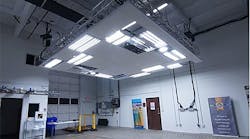The performance race among manufacturers of LED lighting products has pushed the technology into the rarified realm of 200 lumens per Watt (lm/W). In 2017, the U.S. Department of Energy (DOE) began evaluating the performance of several new lighting products with claimed efficacies near or exceeding that level to validate the claimed efficacy, determine the features or characteristics the products had in common and identify any performance tradeoffs.
Researchers at Pacific Northwest National Laboratory anonymously ordered two samples each of seven luminaires – five identified through their LED Lighting Facts listings, and two found through an online search. All of the products were industrial luminaires with correlated color temperatures (CCTs) of 5000K, and all but one had exposed LED emitters.
The results of photometric testing of the samples were compared with the manufacturer-claimed values and samples were also tested for horizontal illuminance, flicker and maximum luminance.
Among their findings, researchers said photometric tests yielded values that were reasonably close to the manufacturers’ claims, with actual lumen output varying from the claims by no more than 9.6%, and actual power draw by no more than 6.8%, while power factors were all above 90%.
When installed in a high-bay space, all of the luminaires produced a fairly even light distribution across the workplane, with a maximum-to-minimum illuminance ratio below 1.7 at a 37-inch standing desk height, the researchers said. But when a group of 23 “knowledgeable observers” were brought in to judge aspects like comfort, they threw a spotlight on the problem of glare.
“Only two of the luminaires received acceptable ratings for visual comfort and overall quality, and those had either diffusing lenses or reflector optics engineered to cut off the view of the bare LEDs above a fixed viewing angle. The two top-rated luminaires received acceptable ratings in categories of light distribution, shadows, and color, in addition to visual comfort. The least-preferred luminaires corresponded to the three that received the most negative comments about glare,” said the report’s summary.
The researchers emphasized that it’s important to take factors beyond efficacy into consideration when choosing a high-output luminaire. Specifiers and purchasers should use the efficacy levels to identify products to consider but should gather more information and see the actual product in action before making a selection.
“There are always tradeoffs in selecting the best luminaire for an application, and efficacy is only one performance aspect to consider. Other attributes – such as visual comfort, light distribution, flicker, shadows, and color quality – are all important.”



